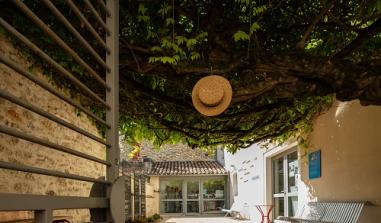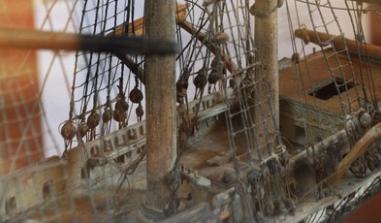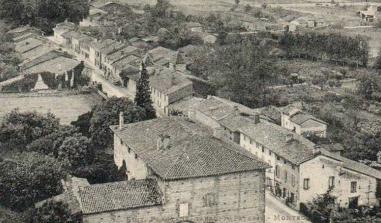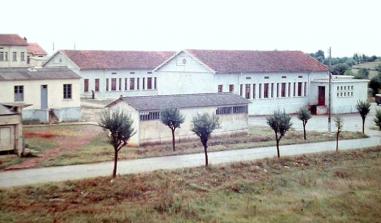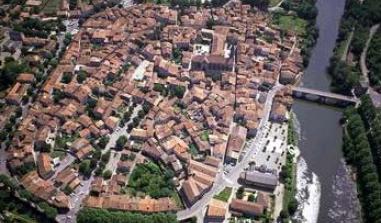Septfonds internment camp
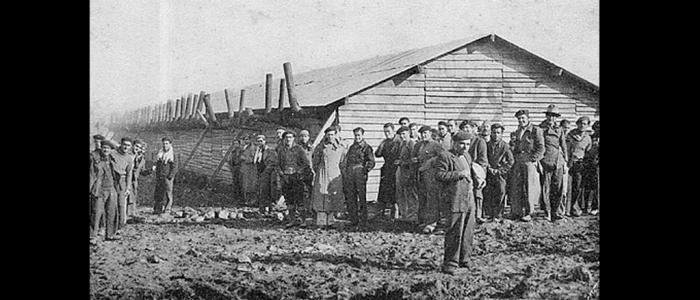
Septfonds 1939. Républicains espagnols parqués au camp de Judes. Source photo : Carte postale
This camp, located in the Tarn-et-Garonne department, was a French detention and internment camp for foreigners.
he Septfonds camp was set up in the context of the massive arrival of Spanish Republican refugees starting in January 1939 and the massive exodus of Jewish populations from the East, called the Ostjuden, who fled Hitler’s Germany.
Three years after General Franco had overthrown the republican government in Madrid in a military coup d’état, the fall of Barcelona on 26 January, 1939, sent 300,000 civilians and 200,000 soldiers on the road to exile.
In February, General Ménard, commander of the military region of Toulouse, was appointed to coordinate the implementation of host facilities. In view of reducing the number of camps in the Pyrénées-Orientales department, the decision was taken to open six major centres along the Spanish border to house 100,000 people: Bram (Aude), Le Vernet (Haute-Garonne), Agde (Hérault), Rivesaltes (Pyrénées-Orientales), Oloraon (Pays Basque), and Septfonds (decision taken on 26 February).
Louis Boucoiran and several senior officers, including General Noël, commander of the 17th military region, definitively chose 50 hectares (125 acres) of sheep-grazing land in the Tarn-et-Garonne department.
Mr Olivier, an architect, and Captain Castéla of the corps of engineers, were put in charge of carrying out the overall plan.
Fifty kilometres of fencing (barbed wire, watchtowers and spotlights) were installed by the army; local road No. 10 was made a throughway; local businesses built some forty barracks, an infirmary an a prison.
Over one thousand soldiers were assigned to oversee the site: six mobile guard platoons, one cavalry squadron from the 20th dragoons, an infantry battalion from the 107th of Angoulême and a battalion from the 16th regiment of Senegalese Tirailleurs from the Guibert Barracks in Montauban.
On 5 March, the first convoy arrived at Septfonds; 2,000 men arrived every day to add to the number of prisoners. As the work was not finished, the first Spanish Republicans were temporarily housed at the La Lande camp before moving to their assigned camp, the Judes Camp, on 16 March. 16,000 Spaniards were squeezed into forty-five barracks made of boards covered with corrugated sheet metal.
As was the case at many Spanish refugee camps, the living conditions were very difficult: problems of sanitation and hygiene, food supply problems, and no running water, heating or electricity in the barracks. At least 81 of them died early on, leading to the creation of a cemetery.
And yet a social, cultural and political life took shape inside the camp: committees or cells of Spanish Communist Party militants were set up; others organised artistic activities; the Spanish children went to school in the village.
Teams were assigned to camp maintenance or sent out for community service work (cleaning sewers and restoring riverbanks, in particular); many were recruited by nearby farmers and industries, notably as part of the service units set up in the summer of 1938. One year later, the threat of war led these workers to be put at the disposal of heavy industry and the army; 79 companies of foreign workers including 20,000 Spaniards were at work when war was declared.
The camp was in operation until 1 March 1940, when it was returned to defence activities. Only the 220th and 221st Companies were kept there for maintenance.
The camp was used for instructing foreigners who joined the French army; it welcomed some 800 pilots from the Polish army in France. With the war, many German refugees fled the Reich. The Spanish refugee camps were reopened. With the collapse of France in May-June 1940 and the establishment of the Vichy government in July, the Septfonds camp became a demobilisation centre for foreign army volunteers, the “residuals” of the African Light Infantry battalions and the French Foreign Legion, as well as French soldiers considered as “undesirables”.
The law of 27 September 1940 eliminated the foreign worker companies (CTE – companies de travailleurs étrangers) and set up foreign worker groups (GTE – groupements de travailleurs étrangers). Three groups were formed at the Septfonds camp: groups 552 and 533, made up of Spaniards, and group 302 for demobilised foreign army volunteers, mainly made up of Jews.
On 17 November, the Vichy government promulgated a law transferring responsibility for oversight of the camps to the Ministry of the Interior. In January 1941, the camp included an internment centre for foreigners, groups of foreign workers and an annex to the town’s hospital. In February 1941, foreigners considered as non-dangerous were gathered here. Having thus become a housing centre for foreigners “in excess numbers in the national economy”, the Septfonds camp, intended for 2,500 people, took in a new category of internees: officers of the Allied army, including Poles. Then came the foreign communists arrested in the Tarn-et-Garonne department at the end of June 1941, who were also held here.
Threatened with closure in the autumn of 1941, the camp became a regional triage centre for foreigners considered as undesirables or lacking proper documentation and who had been arrested in the department. Progressively, Vichy decided to increase the number of supervised Jewish workers through the transfer of internees from other camps, as well as to create groups made up only of Jews. At Septfonds, it was the 302nd “Palestinian” Group of foreign workers. By order of the Ministry of the Interior dated 30 June, the internees were evacuated and the camp was closed. Most of the Jews in the department were put under house arrest until it reopened in August of 1942 as part of the system set up to apply the “Final Solution”, which was put in place in all the territories of the Nazi Reich after the Wansee Conference (January 1942).
After the roundup of the Jews in the department, the 84 GTEs in the camp were sent to Auschwitz, via Drancy, from the Caussade train station. The department’s large roundup of 26 August led to 173 arrests, along with those of Réalville and Montech. For the year 1942 overall, 295 Jews transited through Septfonds.
In November, the Free Zone no longer existed. The camp continued to operate: in the spring of 1943, alongside the 70 deportees, there were foreigners who had been forced to enrol in “Obligatory Work” at the Todt organisation’s worksites, as well as Jewish women “with no resources and no jobs” starting in September 1943.
Septfonds was liberated by the French Résistance in the first half of August 1944 during the “Night of Carnival 44 Attack”.
Between August 1944 and May 1945, when the camp was definitively closed, the site was used to detain five hundred people suspected of collaboration in the department. In most cases, the collaboration concerned economic collaboration, such as providing farm food supplies, construction or repair work.
The site was abandoned for thirty years, and brush covered the barracks and cemeteries. Starting in 1970, institutions and associations decided to turn Septfonds into a memorial. Four sectors were adopted: the Spanish cemetery (located two kilometres from the village), the stele erected in memory of the Jews who were deported (Henry Grau Square), the Polish oratory built by the prisoners before their transfer, and the Camp Memorial. The Spanish cemetery was created in 1978. In 1990, a stele was erected on a square in the village of Septfonds in memory of the 295 Jews deported from the internment camp in August 1942. Two years later, an exhibition presenting a historical overview of the camp and its use at different periods was presented while awaiting the opening, in 1995, of an exhibition and documentation hall at the Résistance and Deportation Museum in Montauban, dedicated to the history of the internment camps in south-western France, notably the Septfonds camp. The Polish oratory, built in 1941 on the camp’s access road, has been restored.
In 1996, the “Septfonds Camp Memorial” was set up and a memorial stele was inaugurated. Two years later, historical signs were installed to complete the memorial site.
Septfonds Town Hall
Rue de la République 82240 Septfonds
Tel.: 05.63.64.90.27
Fax: 05.63.64.90.42
E-mail: mairie-septfonds@info82.com
Tarn-et-Garonne Tourist Office
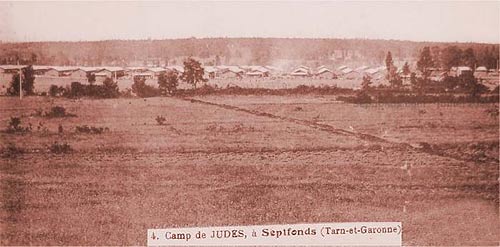
Judes Camp. Source: www.septfonds.com
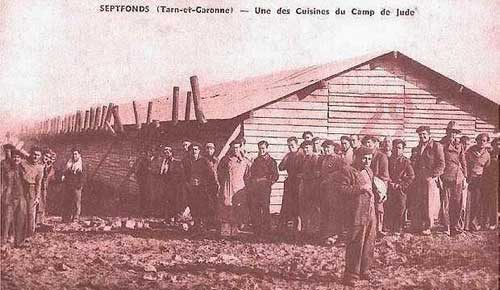
Septfonds Camp. Source: www.septfonds.com
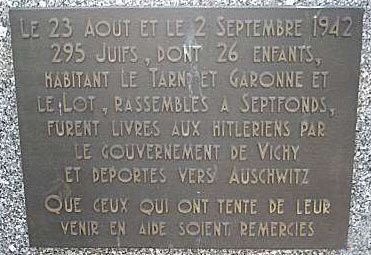
The commemorative plaque in honour of the 295 interned and deported Jews.
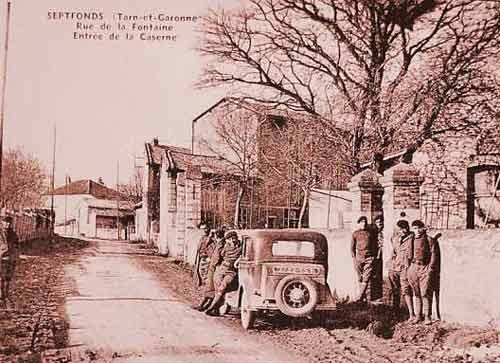
Septfonds barracks. Source: www.septfonds.com
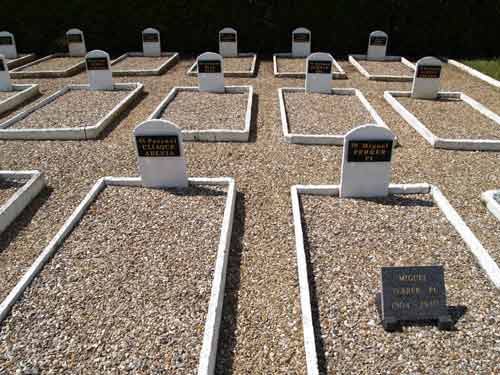
The Spanish Cemetery. Source: site.voila.fr/espana36/septfon/JUDES.htm
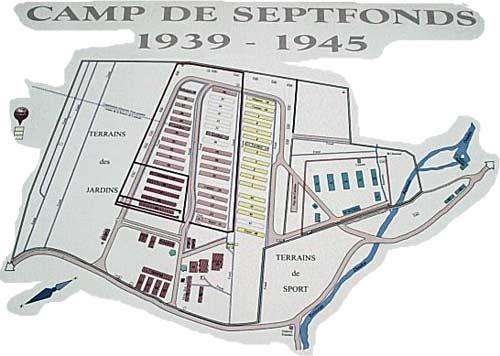
Septfonds Camp. Source: www.septfonds.com
Practical information
82240
Septfonds
Tél. : 05.63.64.90.27 Fax : 05.63.64.90.42
Accessible year-round


